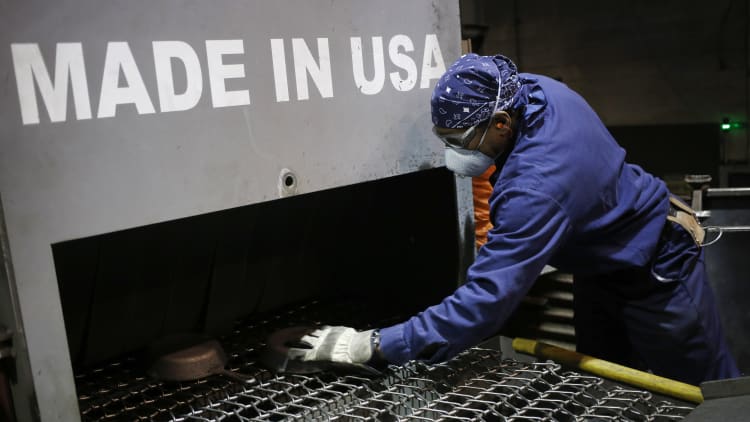
If the US economy is ever going to reach breakout speed, it's got some serious work to do — literally.
Amid a raft of other economic data that has been mixed to trending lower as of late stands one number: a punk productivity level that is holding back economic growth. The trend is important as it stands as likely the primary divider between the acceleration that President Donald Trump has projected against the reality that has been the case for most of the past decade.
"The persistent decline in productivity growth represents one of the most important medium-term global economic challenges," analysts at Moody's said in a lengthy report on the issue released Thursday. "Slow productivity growth, along with population aging, implies that
future output growth will be materially slower than in the past."
Indeed, the productivity issue is not unique to the U.S. Fixes have been elusive, as demographic and other factors collude against generating the type of velocity needed to lift the global economy.
Moody's believes productivity weakness "poses a sizeable downside risk to global economic growth."
Half-full or half-empty?
Productivity, as measured in economic terms, is essentially a measure of how much product comes from labor and investment.
For the first quarter, productivity in the U.S. declined 0.4 percent, according to government data issued Thursday. That translates into yearly improvement of just 1.1 percent — better than the flat growth seen over the past several years but still lagging.
"How you interpret that 1.1 percent depends on whether you're a glass half-empty or half-full person," Andrew Hunter, U.S. economist at Capital Economics, said in a note. "A 1.1 percent gain is better than the near-stagnation in recent years, but still a long way short of the 2 percent-plus pace needed for the real economy to grow at the 3 percent rate the White House is looking for."
The biggest dilemma so far for the administration's growth hopes has been the inability of hard economic data like productivity and sales to catch up to the high expectations among investors, business owners and consumers.
Over the past month or so, the gap has grown wider.
Economic numbers have been missing expectations at a rate not seen since Trump entered the White House in January, according to multiple gauges including the closely watched Citigroup Economic Surprise Index (courtesy Yardeni Research) and the Bespoke Economic Indicator Diffusion Index:
When measured since the end of March, economic surprises vs. expectations are at their weakest level in two years, according to Bespoke's Paul Hickey.
"While the data has been weak relative to expectations, it hasn't necessarily been weak, so it's not as though the economy has been falling off a cliff," Bespoke's Paul Hickey wrote. "Longer term indicators like jobless claims, housing starts, and the ratio of leading to coincident indicators all suggest that the economy remains on a firm footing."
The Fed takes notice
While there are few predictions of recession ahead anytime soon, the data have been weak enough to get the Federal Reserve's attention.
At the conclusion of this week's gathering of central bank policymakers, a post-meeting statement made particular note of how the economy has weakened this year.
Market participants focused on the statement's description of current conditions as "transitory," but central bank officials have been down that road before: The Fed for several years running overestimated the economy's growth rate and thus kept its crisis-era policies in place for longer than virtually anyone expected.
To be sure, economic confidence remains fairly high.
A fresh indicator this week in the form of the PNC economic outlook showed optimism among small businesses at levels never seen before in the survey's 15-year history. Fully 80 percent describe themselves as optimistic about near-term prospects, a level far ahead of the 56 percent from the same time a year ago.
Corporate earnings have been strong as well. Some 77 percent have beaten Wall Street expectations as the first-quarter season winds to a close, with the annualized gain in the 14 percent rage, according to FactSet and S&P Global numbers.
Moreover, the bright spot out of the first-quarter's tepid 0.7 growth was a big jump in investment — a 9.4 percent increase in business outlays overall that included a 22.1 percent surge in structures and a 9.1 percent increase in equipment. The continuation of both would be key ingredients in increasing productivity ahead.
However, the low current level of productivity growth at a time when the jobless rate of 4.5 percent is indicating something close to full employment presents risk.
Goldman Sachs economists advised clients this week that the prospects for a recession over the medium term are "rising" and could force the Fed's hand.
In fact, Goldman believes the Fed may have raise rates at a pace "well beyond current market pricing," a situation that ultimately could produce a recession.


